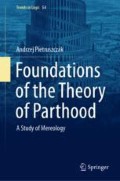Abstract
We have already observed (in Sect. 1.2) that, in the literature, the transitivity of the relation is a part of is often called into question. We cited there a number of works which take different and interesting views on the matter. In this chapter, we will introduce some general approaches which will hopefully delight both defenders and opponents of the assumed transitivity of the relation. We will introduce the concept of the local transitivity of a given relation which will be such that every transitive relation is also locally transitive.
Access this chapter
Tax calculation will be finalised at checkout
Purchases are for personal use only
Notes
- 1.
See Appendix B.1.2.
- 2.
- 3.
Cf. principle (\(\mathrm {M}'_{\scriptscriptstyle \mathrel {\mathsf {sum}}}\)).
- 4.
- 5.
In this sense, axiom \((A4 _{\mathrm {w}}) \) is a “partial version” of axiom (A4).
- 6.
In order not to complicate matters (see the point above), we will not introduce other “partial versions” of the conditions we have examined.
References
Lyons, J. (1977). Semantics (Vol. 1). Cambridge: Cambridge University Press. https://doi.org/10.1017/CBO9781139165693.
Pietruszczak, A. (2012). Ogólna koncepcja bycia częścią całości. Mereologia a nieprzechodnia relacja bycia częścią (A general concept of being a part of a whole. Mereology and the non-transitive relation of being a part.). In J. Golińska-Pilarek & A. Wójtowicz (Eds.), Identyczność znaku czy znak identyczności? (The identify of a sign or the sign of identity?) (pp. 157–179). Warszawa: Wydawnictwa Uniwersytetu Warszawskiego.
Pietruszczak, A. (2014). A general concept of being a part of a whole. Notre Dame Journal of Formal Logic, 55(3), 359–381. https://doi.org/10.1215/00294527-2688069.
Author information
Authors and Affiliations
Corresponding author
Rights and permissions
Copyright information
© 2020 Springer Nature Switzerland AG
About this chapter
Cite this chapter
Pietruszczak, A. (2020). Theories Without the Assumption of Transitivity. In: Foundations of the Theory of Parthood. Trends in Logic, vol 54. Springer, Cham. https://doi.org/10.1007/978-3-030-36533-2_4
Download citation
DOI: https://doi.org/10.1007/978-3-030-36533-2_4
Published:
Publisher Name: Springer, Cham
Print ISBN: 978-3-030-36532-5
Online ISBN: 978-3-030-36533-2
eBook Packages: Mathematics and StatisticsMathematics and Statistics (R0)


 ) does not have to be identical with
) does not have to be identical with  ). See, e.g., Models
). See, e.g., Models